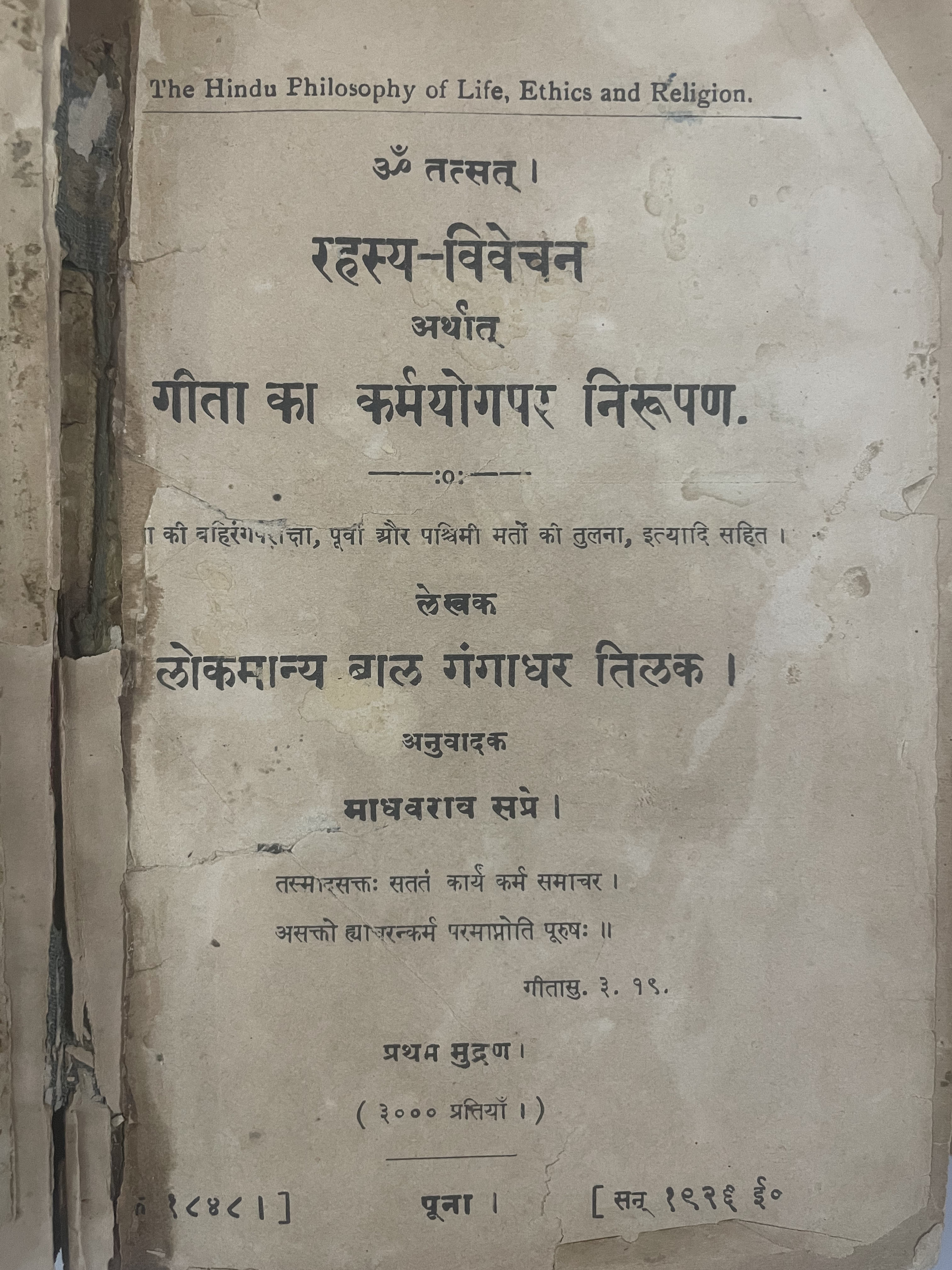Srimad Bhagwad Gita Rahasya vivechan

About
Summary
Exquisite
TOC
Details
Related
URL
Images
Overview
Shrimad Bhagavad Gita Rahasya, also known as Gita Rahasya or Karmayog Shastra, is a book written in Marathi by Bal Gangadhar Tilak in 1915. Tilak wrote the book while imprisoned at Mandalay jail in Burma between 1908 and 1914. It presents an analysis of Karma Yoga, as found in the Bhagavad Gita, a Hindu scripture.Tilak's Gita Rahasya offers a unique interpretation of the Bhagavad Gita, emphasizing the path of Karma Yoga (the Yoga of Action) over Karma Sanyasa (renunciation of action). Tilak argues that the true message of the Gita is selfless action, performed without attachment to results. He critiques Adi Shankara's interpretation, which had popularized the message of renunciation. Tilak defends the ethical obligation of people to act.
The book consists of two parts:
Philosophical Exposition: The first part presents Tilak's philosophical arguments for Karma Yoga. He establishes his thesis using the Mimamsa rule of interpretation.
The Gita, its Translation and Commentary: The second part includes the text of the Gita, its translation, and Tilak's commentary on each verse.
Importance of Book
Reinterpretation of the Gita: Tilak's work offers a fresh perspective on the Gita, challenging traditional interpretations and emphasizing the importance of action in spiritual life.
Influence on the Indian Independence Movement: Tilak's interpretation of the Gita as a call to action inspired many freedom fighters during the Indian independence movement. His emphasis on duty and social responsibility resonated with those who were fighting for their nation's freedom.
Promotion of Karma Yoga: The book helped popularize the concept of Karma Yoga, emphasizing that spiritual growth can be achieved through active engagement in the world.
Encouraging Social Activism: In the book, Tilak emphasizes the importance of social engagement, which resulted in the promotion of social activism.
A cornerstone of the Indian Freedom Struggle: Tilak's book was the cornerstone of the Indian freedom struggle.
Key Themes
Karma Yoga (The Yoga of Action): The path of selfless action as a means to spiritual liberation.
Nishkam Karma (Selfless Action): Performing actions without attachment to results or personal gain.
Duty and Social Responsibility: The importance of fulfilling one's duty and contributing to the welfare of society.
Action over Renunciation: Prioritizing active engagement in the world over complete renunciation.
Finding the true meaning: He tried to find the one meaning and one purpose running through the book.
Cultural Significance
Influence on Indian Nationalism: The book played a crucial role in shaping the ideology of Indian nationalism, emphasizing the importance of action, duty, and social responsibility.
Reinterpretation of Religious Texts: Tilak's work exemplifies the tradition of reinterpreting religious texts to address contemporary social and political concerns.
Promotion of Ethical Values: The book promotes ethical values such as selflessness, duty, and social responsibility, which are central to Indian culture and philosophy.
It is well Known: Lokmanya Tilak decided to make the Shrimad Bhagavad Gita, known to all sections of India, the cornerstone of the Indian freedom struggle.
Effects on Society
Inspired Freedom Fighters: The book inspired countless freedom fighters to dedicate themselves to the cause of Indian independence, viewing their actions as a form of Karma Yoga.
Promoted Social Activism: Tilak's emphasis on social responsibility encouraged many Indians to become actively involved in social reform movements and community service.
Shaped Political Discourse: The book shaped the political discourse of the time, emphasizing the importance of action, duty, and national service.
Contributed to a Sense of National Identity: By reinterpreting the Gita in the context of the Indian independence movement, Tilak helped to forge a sense of national identity and purpose.
Ignited widespread protests: According to search result , his hard work was much appreciated.
Conclusion
Shrimad Bhagavad Gita Rahasya by Bal Gangadhar Tilak is a significant work that offers a unique interpretation of the Bhagavad Gita, emphasizing the path of Karma Yoga and inspiring generations of Indians to dedicate themselves to the cause of social and political reform. The book's importance lies in its reinterpretation of the Gita, its influence on the Indian independence movement, and its promotion of ethical values and social responsibility. Its key themes include Karma Yoga, Nishkam Karma, duty, and action over renunciation. Its cultural significance stems from its role in shaping Indian nationalism and its contribution to the development of a modern Indian identity. The book has had a lasting effect on the country and society, inspiring freedom fighters, promoting social activism, shaping political discourse, and contributing to a sense of national unity.
Title
Srimad Bhagwad Gita Rahasya vivechan
Author
Bal Gangadhar Tilak
Name of Publisher
Ramachandra
Publish Date
1926
Subject
Explore the Bhagavad Gita
Vintage
1901-1947
Category
Philosophy
Sub Category
Religion/Spirituality
Rarity
RARE
